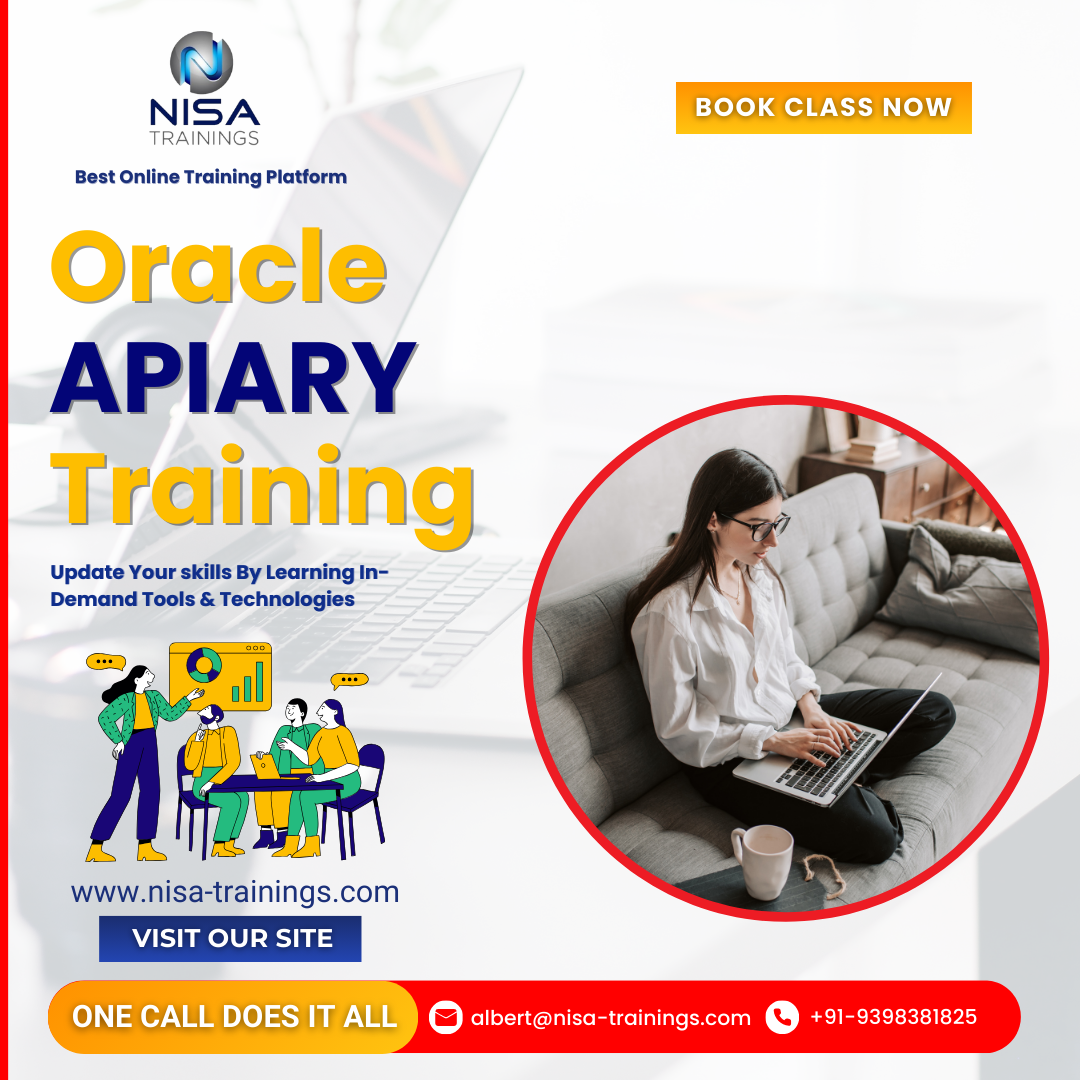Oracle Apiary Training
Oracle APIary is a platform designed for building and managing APIs, enabling developers to design, document, and test their APIs effectively. It provides tools for API development and allows teams to work collaboratively on API specifications, monitoring.

Why should you choose Nisa For Oracle Apiary Training?
Nisa Trainings is the best online training platform for conducting one-on-one interactive live sessions with a 1:1 student-teacher ratio. You can gain hands-on experience by working on near-real-time projects under the guidance of our experienced faculty. We support you even after the completion of the course and happy to clarify your doubts anytime. Our teaching style at Nisa Trainings is entirely hands-on. You’ll have access to our desktop screen and will be actively conducting hands-on labs on your desktop.
Job Assistance
If you face any problem while working on Oracle Apiary Course, then Nisa Trainings is simply a Call/Text/Email away to assist you. We offer Online Job Support for professionals to assist them and to solve their problems in real-time.
The Process we follow for our Online Job Support Service:
- We receive your inquiry for Online Job
- We will arrange a telephone call with our consultant to grasp your complete requirement and the tools you’re
- If our consultant is 100% confident in taking up your requirement and when you are also comfortable with our consultant, we will only agree to provide service. And then you have to make the payment to get the service from
- We will fix the timing for Online Job Support as mutually agreed by you and our consultant.
Course Information
Oracle Apiary Training
Duration: 25 Hours
Timings: Weekdays (1-2 Hours per day) [OR] Weekends (2-3 Hours per day)
Training Method: Instructor Led Online One-on-One Live Interactive
Sessions.
COURSE CONTENT :
1. Introduction to APIs and API Management
- Overview of APIs: What APIs are, how they work, and why they are important.
- API Lifecycle: Understanding the stages of an API’s lifecycle, from design to development, testing, deployment, and versioning.
- API Management Overview: Introduction to Oracle API Management and how APIary fits into it.
2. Getting Started with Oracle APIary
- Setting up Oracle APIary: Account setup, logging in, and navigating the platform.
- Creating Your First API: A hands-on exercise to design and document your first API using APIary.
- Understanding API Blueprint: An introduction to API Blueprint, the format used for designing APIs in APIary.
- Key syntax and structures in API Blueprint (e.g., resources, endpoints, actions, parameters).
- Writing sample API definitions in API Blueprint.
3. API Design with API Blueprint
- Defining Endpoints: How to define HTTP methods (GET, POST, PUT, DELETE) and their paths.
- Request and Response Formats: How to specify the request parameters and response structures.
- Data Types and Models: How to define and reuse data models across different API endpoints.
- Versioning APIs: How to handle versioning of APIs and maintain backward compatibility.
4. API Documentation with Oracle APIary
- Writing Clear API Documentation: Best practices for writing concise and readable API documentation.
- Using the APIary Editor: How to use the APIary Editor to document your API endpoints, request parameters, and responses.
- Interactive API Documentation: How to create interactive API documentation that allows users to try out API calls directly from the documentation (using APIary’s Mock API feature).
- Customizing API Documentation: How to add custom content to your API documentation (e.g., branding, images, guides).
5. Mocking and Testing APIs
- Mocking APIs in APIary: How to create mock APIs that simulate the behavior of your API without having to implement it fully.
- Testing APIs: Using APIary’s built-in tools to test API requests and validate responses.
- Simulating Different Scenarios: How to simulate various scenarios in the mock API to test edge cases, error responses, and success responses.
- Debugging API Calls: Troubleshooting and debugging API interactions in APIary.
6. Collaborative API Development
- Collaboration Tools in APIary: How to work with teams to design, review, and improve APIs collaboratively.
- Version Control: Managing different versions of APIs using APIary’s version control tools.
- User Roles and Permissions: How to manage user roles and permissions to control who can view or edit APIs.
- API Governance: Understanding the policies and processes for maintaining API quality and consistency across teams.
7. Integrating Oracle APIary with Other Tools
- Integrating with Oracle API Platform: How to import/export API definitions to/from Oracle API Platform.
- Connecting to Backend Services: How to link your API to actual backend services (e.g., databases, microservices).
- Using API Gateway for Deployment: Introduction to deploying APIs through the Oracle API Gateway or other API management solutions.
8. Advanced Features of Oracle APIary
- Security and Authentication: How to secure your APIs, including OAuth 2.0 and API keys.
- Rate Limiting and Throttling: How to implement rate limiting and throttling policies for your API.
- Analytics and Monitoring: Using Oracle API Platform or other analytics tools to monitor API usage and performance.
- API Lifecycle Management: Managing the API lifecycle from creation through deprecation and versioning.
9. Best Practices and Real-World Use Cases
- API Design Best Practices: Guidelines on designing APIs that are maintainable, scalable, and easy to consume.
- Case Studies: Reviewing real-world examples and case studies of APIs built with Oracle APIary and other Oracle tools.
- Common Pitfalls and How to Avoid Them: Discussing challenges in API development and how to avoid common mistakes.
